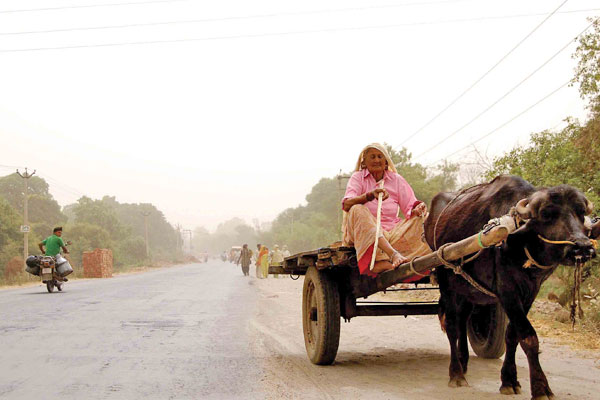ON November 1, 2016, a gala event was organised at Gurgaon, now Gurugram, marking the Golden Jubilee of Haryana’s creation. Prime Minster Narendra Modi, some of his Cabinet colleagues, Haryana Chief Minister Manohar Lal, Ministers of Haryana Government and many other VIPs were present at a glittering ceremony at Tau Devi Lal Stadium. Everyone present was full of verve and enthusiasm, including the Prime Minister and Haryana Chief Minister. I was also present.
Watching the proceedings and pageant, my thoughts went back 50 years and even longer. I had joined the then Punjab as a very young IAS Officer in 1961 after completing one-year training at the National Academy of Administration (as it was then known), Mussoorie (which I had joined in May 1960). Between 1961 and early 1966, there were occasional demands for creation of a separate State of Haryana, sometimes by Haryana leaders and sometimes, oddly enough, by some Punjab leaders who wanted a Punjabi ‘suba’. As long as Sardar Pratap Singh Kairon remained the Chief Minister of Punjab, he was able to deftly neutralise these demands. But once he demitted office following the Das Commission inquiry in the middle of 1964, the State government of Punjab became weaker and the demand for the reorganisation of Punjab and creation of Haryana became stronger. One of the prominent leaders of the Haryana quest was Chaudhary Ranbir Singh (a very eminent freedom fighter and father of Bhupinder Singh Hooda), who was the Irrigation and Power Minister in the Punjab Government.
The Union government, after a lot of deliberations and wide consultations, decided to reorganise Punjab, its second split (the earlier one having happened in 1947 with West Punjab going to Pakistan and East Punjab staying within India). It was much more than mere creation of Haryana as Punjab lost out its beautiful hill areas like Shimla and Kangra to Himachal Pradesh, the area contiguous to Delhi to Haryana and Chandigarh becoming a Union Territory. Bhagwat Dayal Sharma, a veteran Congressman and a seasoned politician became the first Chief Minister of the new State but he lost out in a vote of confidence initiated by some agitated Congress MLAs, including Rao Birender Singh. Unfortunately, Singh also did not last long. In 1968, Bansi Lal became the Chief Minister and he initiated the building up of the State.
Bansi Lal ruled the State with a very firm hand, perhaps modeling himself on Kairon. He had a vision and he was competently and appropriately advised by senior officers. In 1975, he was drafted in the Union government, first as minister without portfolio and then as Defence Minister under Indira Gandhi. He earned a name for himself at the national level and Haryana started getting counted as a front runner. Then followed a string of Chief Ministers, including Banarsi Dass Gupta, Bhajan Lal, Devi Lal, Hukam Singh, Om Prakash Chautala, Bhupinder Singh Hooda and now, Manohar Lal. Some did outstanding work and provided great leadership which transformed the State from a backward region to a highly impressive modern State.
IN the last 50 years, Haryana has moved places. While its area has remained constant and its capital continues at Chandigarh, the number of districts has gone up from six to 22 and the population from one crore to more than 2.5 crores. Unfortunately, the male-female ratio has remained skewed, but more of it later. Of course, the literacy percentage has jumped more than 25 per cent to over 75 per cent. Haryana’s per capita income has gone up more than five times at current prices and at constant prices has trebled. The Plan outlay has gone up from a small amount of Rs. 235 crore in the 4th plan to well over Rs. 1 lakh crore in the 12th plan.
The most impressive growth has been in the agricultural sector as the wheat production has gone up 10 times and rice production almost 20 times. Oil seed production has gone up nearly 10 times and the cotton production more than 7 times. In the field of education, health, transport and communications, Haryana has seen all-round development, partly because of wise leadership, partly because of civil service, partly because of forward-looking people and partly because of proximity to Delhi. Industry has seen a major expansion with very big names coming to Haryana, particularly in Gurgaon, which replaced focal points like Faridabad, Sonipat and Ambala.
Incidentally, Gurgaon (now Gurugram) has emerged as the symbol of Vibrant Haryana. It is often referred to as the ‘Millennium City’. While it has put Haryana on the global economic map, it has also thrown up many new challenges relating to urban planning, transport, pollution, etc. The way the people and the government address these challenges will determine Haryana’s future.
HARYANA is yet to set up a capital of its own and a separate High Court. Haryana shares these two with Punjab and Chandigarh. The Haryana government does not have control on Chandigarh. Now new problems like roads, traffic management, law and order, preservation and disposal of foodgrain stocks and alike have come to the fore. Strangely enough, the sensitivity to the caste system has continued in spite of economic growth and education. It is essentially the polluted political system which is keeping the caste system alive. The Jat agitation sometime ago is an evidence of the caste constituency in politics. The honour killings dictated by Khap Panchayats only strengthen this feeling. On August 15 we completed 70 years of freedom but the caste label is yet to be removed. The other unfortunate phenomenon is the distorted male-female ratio, particularly in Haryana, and in spite of various schemes for protecting the female foetus, female child and women, the mindset has not changed. The big social change which the nation has witnessed since independence is the status of women in society. In Haryana it is also visible but there is strong prejudice against the girl child.

Haryana has a bright future, as India has. Haryana is one of the leading States in the Indian Union with an excellent per capita income, excellent communications, a forward-looking citizenry and a fairly effective administration. All these factors should take the State ahead at a fast pace. What could hold it back is lack of a commonly shared vision, prejudices and complacency.
Almost a year has elapsed since the 2016 function and the most significant occurrence has been the judicial verdict against the Dera Sacha Sauda Chief a couple of months ago. The violence that erupted in its wake left the State shaken and the government busy picking up pieces. It has a certain message to the government: namely, that no organisation should be allowed to grow in a fashion that damages the society. There is also a message to the political class and, of course, the permanent executive, that there should be no compromise with the basic tenets of governance. This is not a lone incident as it was preceded by the Jat agitation and the Rampal episode of Barwala, all within a span of three years or less. We have to watch out.
Two major decisions of the Central government in the last one year, the golden jubilee year of Haryana, have been demonetisation announced by the Prime Minister on November 8, 2016, and the enforcement of GST with effect from July 1, 2017. There has been widespread debate on the benefits of demonetisation and many sections, including some noted economists, have been highly critical of the decision. However, the full impact of demonetisation is yet to unfold and one would hope and wish that it removes the distortions in the Indian Monetary System.
Introduction of GST was long overdue and it will undoubtedly have a huge spin-off for Indian economy, trade and industry. It, however, is passing through its nascent stage and the system is witnessing lots of teething troubles. Recently the Central government announced that many corrective measures are in the offing. Of course, Haryana also should benefit from these measures as the entire country is expected to.
Fifty years may be a short period in the history of a nation, but certainly a long period in the life of man. Those who witnessed the creation of Haryana in November 1966 and had the good fortune of serving the State were full of hope and aspirations as we got cracking. One wonders whether at the age of 50 the State of Haryana is witnessing slowdown associated with middle age! Perhaps not. A strong citizenry, a dynamic political system, an effective permanent executive, close proximity with Delhi and the backup of the economic growth of the last 50 years augur well for the State. However, the prejudices which some sections of the society still nurture, like the caste prejudice and the negative attitude towards the girl child, have to be eschewed. There is no easy way to success and the government and the people of the State have to continue to strive hard to make it an ideal state to live in. Unfortunately, the slogan of Clean India, ‘Swachh Bharat’, is yet to be given a full meaning and I do hope we would realise it sooner than later!
As I look back, I venture to make a few suggestions. One is that the urban-rural divide, which has gone on for long years and becomes apparent in many ways, has now to be given a go by. In many parts of the country, including in Haryana, villages are straining to urbanise and the cities are merrily nibbling at the villages. It is time that we gave up the urban versus rural approach and concentrated on area development with a major city or town as the nodal point.
SECONDLY, it may be a good idea to make all Blocks co-terminus with Tehsils, with one officer in charge of revenue, development and executive functions. It will, in many ways, bring administration to the doorstep of the citizens. Thirdly, there should be convergence of services at the village level. It may be worth considering if the functions of the Patwari, Gram Sewak and the village-level agriculture functionary are merged and each village in Haryana—numbering nearly 7,000—has one functionary answerable for all these responsibilities. This may need some readjustment in the higher echelons of government, namely at the departmental level and the State headquarters, but it may be worthwhile. Fourthly, it is time to relook at the transfer policy of the government, particularly of teachers in government schools. Most government officials, except may be in the department of police and excise, should be posted in home districts. Getting posted in home districts is only the beginning, accountability should follow. Of course, gazetted officers could be posted anywhere in the State.
Haryana has a bright future but the people of the State and those who are responsible for its management have to put in their best efforts to make it happen. Haryana is the land of Mahabharata and Bhagwad Gita. The last verse of the Bhagwad Gita reads as follows:
यत्र योगेश्वरः कृष्णो यत्र पार्थो धनुर्धरः ।
तत्र श्रीर्विजयो भूतिर्ध्रुवा नीतिर्मतिर्मम ॥
(Where wisdom and strategy (epitomised by Lord Krishna) and effective action (as Arjuna) come together, prosperity, victory (over poverty and evil) and sustainable policies follow) This is my view.
So be it with Modern Haryana. Let wisdom and correct action prevail!
The writer is a former Chief Secretary of Haryana






























































